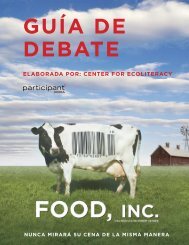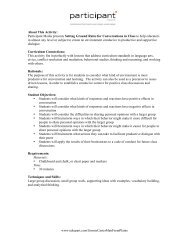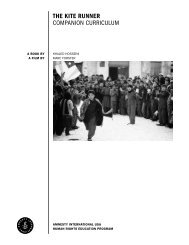Food Inc. Discussion - TakePart
Food Inc. Discussion - TakePart
Food Inc. Discussion - TakePart
You also want an ePaper? Increase the reach of your titles
YUMPU automatically turns print PDFs into web optimized ePapers that Google loves.
eakfast cereals, salad dressings, margarines, syrups, and snacks, as well as<br />
products like baby powder, glue, soap, alcohol, medicine, and fuel ethanol.<br />
The iconic American meal of a cheeseburger, fries, and shake includes several<br />
corn-based ingredients: the patty (corn-fed beef), the cheese (cornstarch), the<br />
bun (high-fructose corn syrup), the ketchup (high-fructose corn syrup and corn<br />
syrup), the fries (corn oil), and the shake (corn syrup solids and cellulose gum).<br />
See the Corn from A to Z student handout, page 37, for a partial list of cornbased<br />
food ingredients.<br />
The United States is currently the number one corn-growing country in the world,<br />
with more acres devoted to corn than any other crop. In 1920, an acre cornfield<br />
yielded just 20 bushels of corn, compared to 180 bushels today. Several factors<br />
have led to both the higher yield and the greater total acreage of corn.<br />
First, in 1930, a hybrid seed was developed that produced plants with sturdier<br />
stalks, allowing them to be grown very closely together and to resist being blown<br />
over. Then, in 1947, scientists discovered a way to convert surplus ammonium<br />
nitrate (which had been used in explosives during World War II) into a chemical<br />
fertilizer that increased soil nitrogen levels; this made it possible to grow corn<br />
from year to year without exhausting the soil. In the 1970s, a major change in<br />
the U.S. farm policy included direct payments to farmers and encouraged them<br />
to grow corn and sell it at any price; not surprisingly, this resulted in a dramatic<br />
increase in the total U.S. acreage of corn as many farmers converted their land to<br />
field corn. More recently, the federal push for corn-based ethanol production as<br />
an alternative to fossil fuels prompted farmers to convert more land to field corn.<br />
In the 1960s and 1970s, scientists discovered how to develop a low-cost<br />
sweetener from corn known as high-fructose corn syrup. Since that time, highfructose<br />
corn syrup and corn by-products have found their way into nearly every<br />
processed food and drink sold today. While cattle, pigs, poultry, and sheep eat<br />
about 60 percent of the corn grain that is grown each year, most of the remaining<br />
corn is processed at a wet mill, which turns it into a variety of substances. The<br />
skin of the kernel becomes vitamins and nutritional supplements; the germ is<br />
crushed for corn oils; and the rest of the kernel—the starchy endosperm—is made<br />
into acids, sugars (including high-fructose corn syrup), starches, and alcohols.<br />
3 2<br />
F o o d , I n c . D I S C U S S I O N G U I D E © P a r t I C I P a N t M E D I a









